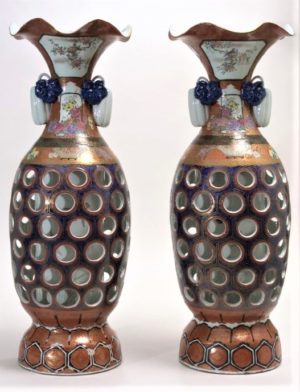
Nanri Kajū II, pair of vases, c. 1875, porcelain with underglaze blue and overglaze enameling and gilding, 75.7 cm high (Philadelphia Museum of Art)
Meiji period (1868–1912)
1868 was a watershed year for Japan. After over two centuries of shogunal rule, practical political power was restored to the emperor (Meiji). 15 years earlier, the American commodore Matthew Perry led a military and diplomatic expedition to Japan, opening the country to foreign trade and thereby ending the Tokugawa-imposed self-isolation policy. The effects of this forcible “opening” were manifold and deeply affected Japan’s social and cultural fabric. Japan began to participate in World’s Fairs, curating displays of samples of Japanese cultural tradition designed for the outside world to see, and often taking the form of new porcelain vases that impressed through their monumental scale, technical excellence, and intricate decoration.
In the realm of painting, the 1870s saw a new mode of image-making that embraced western styles and techniques, known in Japanese as yōga 洋画 (“Western-style painting.”) A pioneering yōga artist, Takahashi Yuichi assisted Antonio Fontanesi, the “foreign advisor” appointed by the Meiji government to teach oil painting at the newly established Technical Fine Arts School in Tokyo. Further developed by painters like Kuroda Seiki, who studied extensively in Paris and worked in Japan into the 1920s, yōga largely embraced contemporaneous styles of French painting, from the Barbizon School to Impressionism, and their connected practices, from painting from nature to favoring subject matter drawn from the here and now.
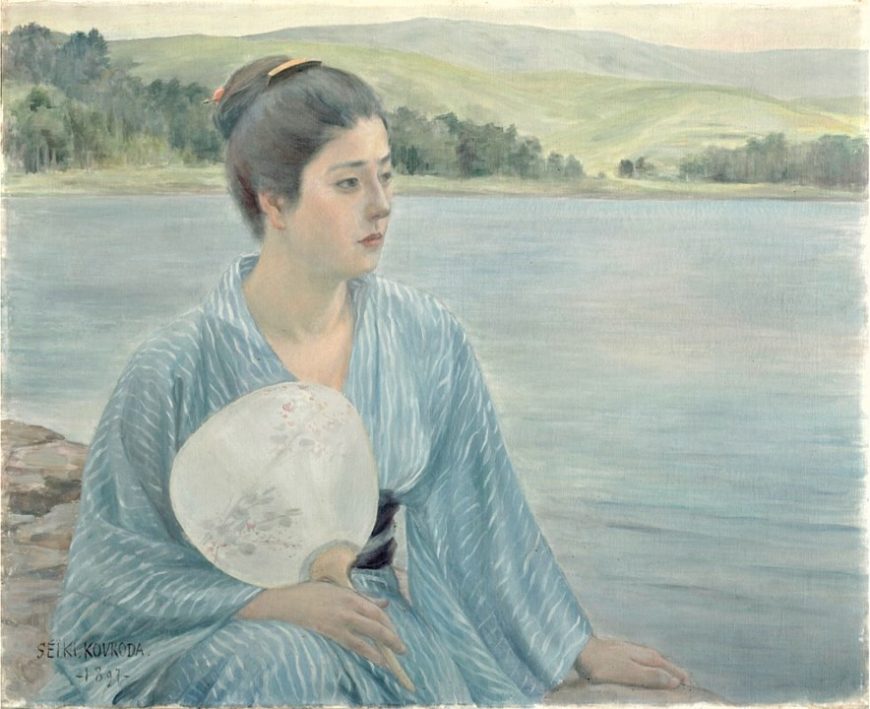
Kuroda Seiki, Lakeside, 1897, oil on canvas, 69 x 84 cm (Important Cultural Property, Tokyo National Museum)
As a foil to yōga, other Japanese visual artists developed a parallel mode of painting, known as nihonga 日本画 (literally, “Japanese painting.”) Rejecting a straightforward adoption of techniques and styles from Euro-American pictorial traditions, nihonga was not a direct continuation of the earlier yamato-e either. Instead, nihonga broadened the traditional themes of yamato-e, created new blends of Japanese stylistic traditions like Kanō and Rinpa, and even incorporated western modes of pictorial realism in its reinvention of Japanese painting.
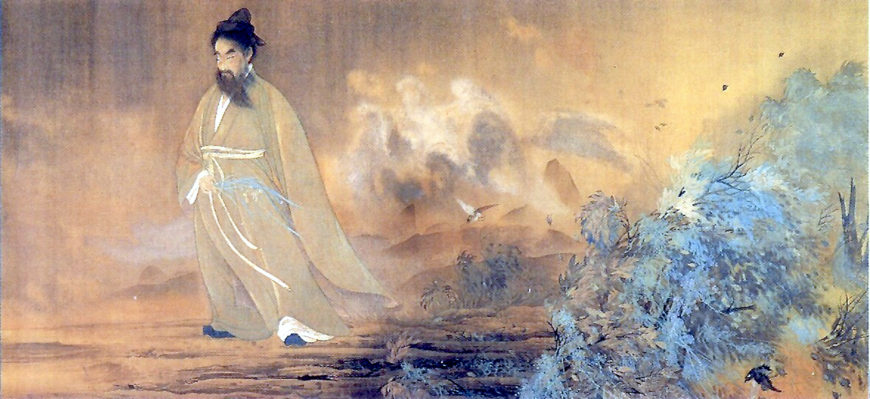
Yokoyama Taikan, Kutsugen (The Legendary Chinese Poet Qu Yuan), 1898, hanging scroll, colors on silk, 132.7 × 289.7 cm (Itsukushima shrine, Hiroshima, image: public domain). This painting is thought to express the painter’s loyalty to his teacher—the influential, if controversial, thinker Okakura Kakuzō. Resentful against oppressive authority, this classical Chinese poet becomes here a surrogate for Okakura, who had just resigned from the new Tokyo Fine Arts School because of internal frictions.
Two artists who significantly shaped nihonga were Kanō Hōgai and Yokoyama Taikan. Remembered as the last great master of the Kanō school, Kanō Hōgai helped pioneer nihonga alongside fellow painter Hashimoto Gahō, himself trained in the Kanō style, and Ernest Fenollosa, an American poet and art critic who assumed important cultural positions in Meiji-period Japan, as professor of philosophy and curator at the newly established Tokyo Imperial University and Imperial Museum, respectively. Modeled on European and American universities and museums, such institutions altered the old structures of the Japanese cultural field. New words became necessary in the Japanese language to translate and use foreign concepts such as “fine art” or “artist.” Thinkers like Fenollosa or Okakura Kakuzō—a sort of cultural ambassador who explained, through his subjective lens, Japanese culture to elite American audiences—affected both the production and the reception of what constituted “Japanese art” in the Meiji period. Born out of Okakura’s teachings on traditional Japanese culture was the quintessentially nihonga style of painter Yokoyama Taikan. His paintings combine canonically Japanese and western-inspired elements with unconventional techniques and high symbolic content.

Otagaki Rengetsu, Sencha cups with poems, 19th century, white stoneware, 4.13 × 6.51 × 6.35 cm (Minneapolis Institute of Art)
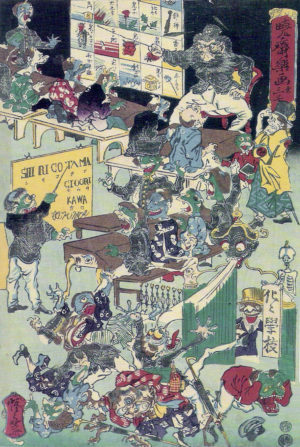
Kawanabe Kyosai, School for Demons and Ghosts, 1870s, woodblock print (image: public domain). Here, Kyosai imagines demons and other fantastical creatures learning new vocabulary—a commentary on the newly instituted Meiji-period compulsory education.
Yet other modes of painting co-existed with the strong yōga and nihonga trends. Somewhat aligned with Euro-American post-Impressionism, the artist Tomioka Tessai created his individualistic style through an inventive blend of influences, largely drawn from classical Japanese and Chinese sources. Tessai’s mentor, friend, and frequent collaborator was Otagaki Rengetsu, an artist and Buddhist nun who expressed her unique style via pottery, poetry, painting, and calligraphy. Another idiosyncratic artist of the period was Kawanabe Kyōsai, who “translated” his experience of the drastic changes that Japan underwent in the 19th century into caricatures within an exuberantly inventive pictorial realm. Through such artists, the Meiji period furthered the spirit of centuries of poetic and playful interplay among mediums and styles in Japanese arts.
Spurred by new ideas about the nation-state and by the reconfiguration of society in the modern era, Japanese urban life was transformed in the Meiji period. With this transformation came different modes of living and new architectural styles for buildings that housed newly established public institutions and for family homes, influenced by western-centric concepts of domesticity. Modeled on western architecture, buildings were built with brick and stone instead of the traditional wood. Merging international and indigenous elements, an eclectic architectural style emerged, championed by architects like Itō Chūta, who also helped establish cultural preservation laws for ancient structures such as temples and shrines.
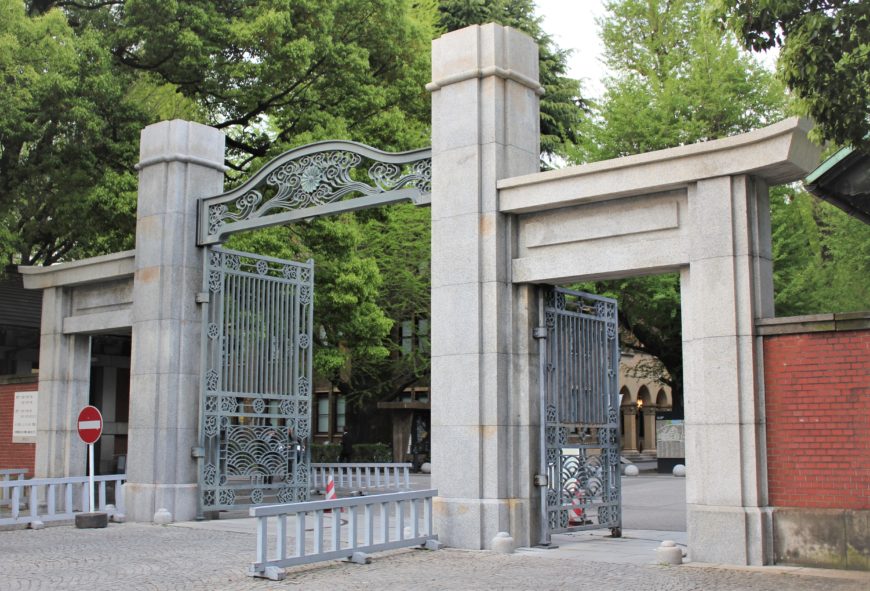
Itō Chūta, Main Gate, Tokyo Imperial University (currently the University of Tokyo), built 1912. This gate is emblematic of Meiji-period architecture as it combines Euro-American elements—note the use of steel and granite—and Japanese elements—note the traditional gate style, known as kabuki-mon (photo: XIIIfromTOKYO, CC BY-SA 3.0)

